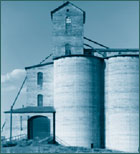
“It is their architectural beauty on the landscape that appeals to me, regardless of a mountainous background or a prairie,” says Selyem, interviewed in his home outside Bozeman, Montana, as we observe a vast array of photographs of elevators on the walls. (His mailbox is in the shape of a grain elevator.)
Since the mid-nineteenth century, grain elevators- many constructed of wood, but sometimes of tile or concrete-have been used in North America to store grain before it is transported to a mill for processing. Most elevators were built at train depots or river terminals. As the economics of agriculture changed, many have lost their value and some have disappeared.
Selyem began searching out old grain elevators as photographic subjects five years after his initial encounter. At times, he would return to his favorite places to “get better light-and the grain elevator would be gone.” This saddened him. “Almost that entire wall of grain elevators are now gone, ” he says.
By 1995, Selyem had a large collection of photographs, but wanted to do more. “Seeing the Coliseum in Rome is different from seeing a picture of it. I cannot connect with it in the same way as in a picture or a story in a magazine.” Selyem travels with a photographic slide show, but he points out that his slide show “cannot convey what is outside the viewfinder . . . the sound of a train going by, meadowlarks, all of the sensations outside.”
He formed the Country Grain Elevator Historical Society to promote the preservation of the old structures. Based in Montana, the society reaches out to communities around North America. Selyem’s wife, Barbara Krupp- Selyem, whom he met when she worked in the grain industry, is vice president of the society. A professional writer, she devotes a lot of time to the society, often recording the history of picturesque elevators.
“The organization collects the history and leaves the community, having planted a seed,” says Selyem. Such a seed was planted for a one-of-a-kind Gothic Revival grain elevator in Ithaca, Nebraska. The elevator’s unique architecture, rarity, and age (it was built in the 1880s) made preservation especially desirable. Selyem’s interest attracted a new private owner who is dedicated to avoiding the grain elevator’s extinction.
Typically, concerned individuals across the nation alert the society that a grain elevator is in jeopardy. Because most grain elevators are privately owned, they can be purchased to avoid demolition. Then they can be converted into useful spaces. “They can be museums, rock climbing gyms, bars and restaurants, houses, or office spaces,” says Selyem. “People with creative minds who are willing to take risks can preserve the beauty of these buildings and use them for economic reasons.”
In Selyem’s view, the new use should maintain the grain elevator’s external integrity. The historical society provides architectural advice to people considering renovating a grain elevator. “We tell them what we have learned, what’s already been done, and what contacts to use for repairs or renovation.”
Although many people appreciate grain elevators, says Selyem, “some people need some encouragement.” Once the society shows an interest in a decaying or dilapidated elevator, the owners begin to do so as well.
“In the early 1990s,” he recalls, “I was waiting for the light to get better, and the camera was on a tripod. The man who owned the grain elevator that I was trying to capture drove over in his pickup truck and asked, “Why are you doing this?'”
Selyem simply replied to the man, “I am taking pictures to preserve its history.” The owner then inquired if he could look through the camera. Selyem permitted the man to do so. “I guess it really is a beautiful old building,” said the owner.
“The elevator is gone now,” says Selyem, “but this man, who owned the grain elevator for decades and dealt with its problems, was able to look through the lens and take it out of context. The man was able to appreciate what it was at that moment. That is what it’s all about.”
Selyem does encounter people who perceive grain elevators as ugly. He is also aware that they can’t all be saved -“and that’s okay.” But Selyem believes that “some should be saved as a visual reminder of the past.”
One of the organization’s main goals is to acquire a grain elevator to serve as its headquarters and as a museum. To promote awareness of elevators, the society occupies a booth at grain and feed industry trade shows. People usually inquire about photographs of their local grain elevator, and nostalgic memories fill the air around the booth.
“Generally, older people are more interested in preservation,” Selyem explains. “Younger people do not connect with the aesthetics, the history, or the characteristics of the grain elevators.” They currently work in or around them and fail to notice their distinctiveness. But, he asks, “When these young people are older and eventually come to appreciate them, will they all be gone?”
The grain elevator that Selyem randomly captured in 1985 is located just off Highway 84 heading to Norris, Montana. Privately owned, it is under renovation to become a residence. The side facing the highway will retain its original appearance, but the side hidden from the road will have windows and decks.
To Selyem, all grain elevators are beautiful. “Each of them has a story. Each has a personality. All of the old ones have the same, basic structure on the outside, just like humans. Each one is unique, just as we have our own personality and character.” Selyem adds, “You really have to notice them.”
Ashley Fingarson is a student at Montana State University. For more information about Bruce Selyem or the Country Grain Elevator Historical Society, see www.country-grain-elevator-historical- society.org.


